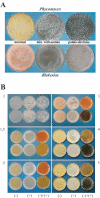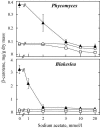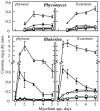Modification of sexual development and carotene production by acetate and other small carboxylic acids in Blakeslea trispora and Phycomyces blakesleeanus
- PMID: 16820488
- PMCID: PMC1489343
- DOI: 10.1128/AEM.02845-05
Modification of sexual development and carotene production by acetate and other small carboxylic acids in Blakeslea trispora and Phycomyces blakesleeanus
Abstract
In Phycomyces blakesleeanus and Blakeslea trispora (order Mucorales, class Zygomycetes), sexual interaction on solid substrates leads to zygospore development and to increased carotene production (sexual carotenogenesis). Addition of small quantities of acetate, propionate, lactate, or leucine to mated cultures on minimal medium stimulated zygospore production and inhibited sexual carotenogenesis in both Phycomyces and Blakeslea. In Blakeslea, the threshold acetate concentration was <1 mmol/liter for both effects, and the concentrations that had one-half of the maximal effect were <2 mmol/liter for carotenogenesis and >7 mmol/liter for zygosporogenesis. The effects on Phycomyces were similar, but the concentrations of acetate had to be multiplied by ca. 3 to obtain the same results. Inhibition of sexual carotenogenesis by acetate occurred normally in Phycomyces mutants that cannot use acetate as a carbon source and in mutants whose dormant spores cannot be activated by acetate. Small carboxylic acids may be signals that, independent of their ability to trigger spore germination in Phycomyces, modify metabolism and development during the sexual cycle of Phycomyces and Blakeslea, uncoupling two processes that were thought to be linked and mediated by a common mechanism.
Figures




Similar articles
-
Ubiquinone and carotene production in the Mucorales Blakeslea and Phycomyces.Appl Microbiol Biotechnol. 2007 Oct;76(5):991-9. doi: 10.1007/s00253-007-1069-7. Epub 2007 Jul 4. Appl Microbiol Biotechnol. 2007. PMID: 17609943
-
Apocarotenoids in the sexual interaction of Phycomyces blakesleeanus.Org Biomol Chem. 2012 Apr 21;10(15):3002-9. doi: 10.1039/c2ob07147a. Epub 2012 Mar 9. Org Biomol Chem. 2012. PMID: 22402921
-
A review of factors affecting biosynthesis of carotenoids by the order Mucorales.Mycopathologia. 1985 May;90(2):65-80. doi: 10.1007/BF00436853. Mycopathologia. 1985. PMID: 3892300 Review.
-
12-O-tetradecanoyl phorbol-13-acetate interferes with germination of Phycomyces blakesleeanus sporangiospores.FEBS Lett. 1988 Oct 10;238(2):441-4. doi: 10.1016/0014-5793(88)80528-3. FEBS Lett. 1988. PMID: 2844610
-
Occurrence and Chemical Synthesis of Apocarotenoids from Mucorales: A Review.Nat Prod Commun. 2017 May;12(5):733-741. Nat Prod Commun. 2017. PMID: 30496683 Review.
Cited by
-
Genes involved in carotene synthesis and mating in Blakeslea trispora.Curr Genet. 2008 Sep;54(3):143-52. doi: 10.1007/s00294-008-0206-x. Epub 2008 Aug 2. Curr Genet. 2008. PMID: 18677485
-
Identification of the gene responsible for torulene cleavage in the Neurospora carotenoid pathway.Mol Genet Genomics. 2007 Nov;278(5):527-37. doi: 10.1007/s00438-007-0269-2. Epub 2007 Jul 4. Mol Genet Genomics. 2007. PMID: 17610084
-
Gene expression in the regulation of carotene biosynthesis in Phycomyces.Curr Genet. 2008 Mar;53(3):129-37. doi: 10.1007/s00294-007-0170-x. Epub 2008 Jan 9. Curr Genet. 2008. PMID: 18183399
-
Carotenoids from Rhodotorula and Phaffia: yeasts of biotechnological importance.J Ind Microbiol Biotechnol. 2009 Feb;36(2):163-80. doi: 10.1007/s10295-008-0492-9. Epub 2008 Nov 4. J Ind Microbiol Biotechnol. 2009. PMID: 18982370 Review.
References
-
- Austin, D. J., J. D. Bullock, and D. Darke. 1970. The biosynthesis of trisporic acids from β-carotene via retinal and trisporol. Experientia 26:348-349. - PubMed
-
- Avalos, J., and E. Cerdá-Olmedo. 2004. Fungal carotenoid production, p. 367-378. In D. K. Arora (ed.), Handbook of fungal biotechnology. Marcel Dekker, Inc., New York, N.Y.
-
- Bejarano, E. R., and E. Cerdá-Olmedo. 1992. Independence of the carotene and sterol pathways of Phycomyces. FEBS Lett. 306:209-212. - PubMed
-
- Bejarano, E. R., F. Parra, F. J. Murillo, and E. Cerdá-Olmedo. 1988. End-product regulation of carotenogenesis in Phycomyces. Arch. Microbiol. 150:209-214.
Publication types
MeSH terms
Substances
LinkOut - more resources
Full Text Sources

